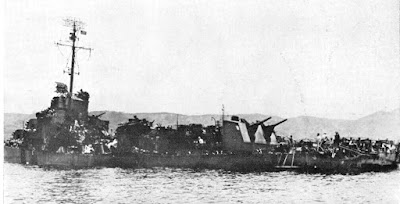ComNavOps has pointed out the West’s tendency toward
individual, one-at-a-time mine hunting and neutralization and how utterly
impractical this would be in combat.
There’s no getting around the fact that large scale, large area, short
time frame mine clearance can only be accomplished by some type of sweeping
operation – the exact opposite of what the West is doing. There is, however, one example of a
minesweeping technology that is moving along the right path and that is the ThyssenKrupp
Marine Systems SAM3 unmanned minesweeping vessel. The vessel is described in a sales brochure
(1) as a small catamaran design ‘sled’ (I would describe it as a pontoon style
craft) that is remotely operated. The
sweep units are capable of being operated in tandem to simulate larger target
signals (like carriers or large commercial cargo/tankers?).
Specifications[2]:
Length 14.4
m
Beam 6.7 m
Draught 1.2 m
Displacement 14 tons
Speed, transit 10 knots
Sweep Speed 8 knots
Power Diesel 2x140 KW
Sweep Depth 3-60 m
Note that the sweep speed is a very low 8 kts. This is not going to clear large areas in a
short time unless many, many units are used simultaneously and it is unknown
whether this is even possible from a signal interference and command/control
perspective. A sales brochure claims
that four sweeper units can be operated together. Whether multiple groups of four can be
operated in the same general area is unknown.
The main feature of the unit is that the sweep signal is
programmable with “magnitude and shape
tuning of both magnetic and acoustic signatures”[1], making this a ‘smart’
sweeper which allows effects such as[1]:
It is this output signal manipulation capability that is the
key. Modern smart mines use a combination
of input signals to determine triggering and we have to have sweeps that can
simulate realistic, multi-aspect output signals in order to trigger a
mine. To the best of my knowledge, the
LCS unmanned influence sweep system (UISS) does not use dynamically
programmable signals and, if true, this will prove to be a major failure in
real world operations.
ComNavOps has also expressed doubt that current minesweeping
technology is capable of clearing (meaning triggering) modern mines which can
use a variety of magnetic, seismic, pressure, and electrical signatures to
distinguish real targets from sweep signals.
To the best of my knowledge, there has been very little research done on
modern sweeping and even less interest shown by the US Navy. This ThyssenKrupp Marine Systems minesweeping
unit would appear to be one of the few examples of ‘smart’ sweeping
technology. Of course, how well it works
is unknown.
I’m unaware of any minesweeping test, in modern times, that
has actually tested sweeping technology against real mines (remove the
explosive and just see if the mines were triggered or not), deployed in real
conditions.
The lack of real world testing should be extremely
worrisome. Combine this with the Navy’s
near absence of any functioning mine clearance assets (the MH-53E helos are
decades past scheduled retirement and only a handful are even flight worthy let
alone mission capable and the Avenger class minesweepers are long overdue for
retirement and most are not capable of sailing) and we have a major
vulnerability that can cripple and paralyze fleet operations.
______________________________
Beam 6.7 m
Draught 1.2 m
Displacement 14 tons
Speed, transit 10 knots
Sweep Speed 8 knots
Power Diesel 2x140 KW
Sweep Depth 3-60 m
- Correct signal levels, variation and duration for a specific target vessel type, size and speed
- Synchronization of magnetic and acoustic signature output
- “Ripple” effect for degaussing simulation
- Simulation of multiple passes for mines with ship-counting device











